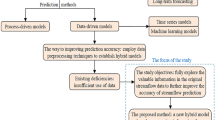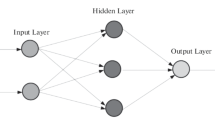Abstract
In this study, three ensemble and decomposition methods (DMs), i.e., empirical mode decomposition (EMD), ensemble empirical mode decomposition (EEMD), and improved complete ensemble empirical mode decomposition with additive noise (ICEEMDAN) were coupled with artificial intelligence and machine learning based method AI-ML, i.e., multilayer perceptron (MLP), support vector regression (SVR) to develop six fundamental hybrid models to predict streamflow with one-month lead time. Developed models in this study were categorized into runoff models (RMs) and rainfall–runoff models (RRMs). Results indicated that (i) among standalone models (SMs), support vector regression (SVR) performs better than multilayer perceptron (MLP), (ii) decomposition methods (DMs) can improve the accuracy rate of the standalone models (SMs), and (iii) rainfall–runoff models (RRMs) have shown great accuracy throughout the investigation as compared to runoff models (RMs). To compare model performances, flow hydrographs (FHGs) were generated, and five performance evaluation criteria (PEC) were used to quantify the model precision. Two-step verification methods, i.e., extreme value analysis (EVA) and least value analysis (LVA) approaches, were proposed to verify the performances. Among all developed hybrid models (HMs), i.e., EMD-(MLP, SVR), EEMD-(MLP, SVR), and ICEEMDAN-(MLP, SVR), rainfall–runoff ICEEMDAN-(SVR) model was selected as an optimal model with MAE (59.56), RMSE (91.82), R (0.97) MAPE (8.75), and NSEC (0.97) for Mangla watershed, Pakistan.







Similar content being viewed by others
Data Availability
All the data were analyzed using MATLAB. The data used to support the findings of this study are available from the corresponding author upon request.
References
Adamowski J, Sun K (2010) Development of a coupled wavelet transform and neural network method for flow forecasting of non-perennial rivers in semi-arid watersheds. J Hydrol 390:85–91
Aggarwal SK, Goel A, Singh VP (2012) Stage and discharge forecasting by SVM and ANN techniques. Water Resour Manag 26:3705–3724. https://doi.org/10.1007/s11269-012-0098-x
Ahmed JA, Sarma AK (2007) Artificial neural network model for synthetic streamflow generation. Water Resour Manag 21:1015–1029
Alam A, Bhat MS, Maheen M (2020) Using Landsat satellite data for assessing the land use and land cover change in Kashmir valley. GeoJournal 85:1529–1543
Ali Z, Hussain I, Faisal M et al (2017) Forecasting drought using multilayer perceptron artificial neural network model. Adv Meteorol. https://doi.org/10.1155/2017/5681308
Azam MI, Guo J, Shi X et al (2020) Spatial climatic variability and impact of El niño-southern oscillation on extreme precipitation of river catchment. Environ Eng Sci 37:346–364. https://doi.org/10.1089/ees.2019.0440
Beheshti Z, Firouzi M, Shamsuddin SM et al (2016) A new rainfall forecasting model using the CAPSO algorithm and an artificial neural network. Neural Comput Appl 27:2551–2565
Bhagwat PP, Maity R (2012) Multistep-ahead river flow prediction using LS-SVR at daily scale. J Water Resour Prot 4:528
Cigizoglu HK (2009) Estimation, forecasting and extrapolation of river flows by artificial neural networks. Hydrol Sci J 48:349–361. https://doi.org/10.1623/HYSJ.48.3.349.45288
Dehghani R, Torabi Poudeh H, Younesi H, Shahinejad B (2020) Daily streamflow prediction using support vector machine-artificial flora (SVM-AF) hybrid model. Acta Geophys 68:1763–1778
Di C, Yang X, Wang X (2014) A four-stage hybrid model for hydrological time series forecasting. PLoS ONE 9:e104663
Domingos SDO, de Oliveira JF, de Mattos Neto PS (2019) An intelligent hybridization of ARIMA with machine learning models for time series forecasting. Knowl-Based Syst 175:72–86
Ghasempour R, Azamathulla HM, Roushangar K (2021) EEMD- and VMD-based hybrid GPR models for river streamflow point and interval predictions. Water Supply. https://doi.org/10.2166/WS.2021.151
Haider H, Zaman M, Liu S et al (2020) Appraisal of climate change and its impact on water resources of pakistan: a case study of mangla watershed. Atmosphere. https://doi.org/10.3390/atmos11101071
Hassan Z, Shabbir R, Ahmad SS et al (2016) Dynamics of land use and land cover change (LULCC) using geospatial techniques: a case study of Islamabad Pakistan. Springerplus 5:1–11
Hearst MA, Dumais ST, Osuna E et al (1998) Support vector machines. IEEE Intell Syst Appl 13:18–28. https://doi.org/10.1109/5254.708428
Huang NE, Shen Z, Long SR et al (1998) The empirical mode decomposition and the Hilbert spectrum for nonlinear and non-stationary time series analysis. Proc R Soc London Ser A Math Phys Eng Sci 454:903–995. https://doi.org/10.1098/RSPA.1998.0193
Huang NE, Wu Z (2008) A review on Hilbert-Huang transform: method and its applications to geophysical studies. Rev Geophys. https://doi.org/10.1029/2007RG000228
Huo Z, Feng S, Kang S et al (2012) Integrated neural networks for monthly river flow estimation in arid inland basin of Northwest China. J Hydrol 420–421:159–170. https://doi.org/10.1016/J.JHYDROL.2011.11.054
Iqbal MF, Khan IA (2014) Spatiotemporal land use land cover change analysis and erosion risk mapping of Azad Jammu and Kashmir, Pakistan. Egypt J Remote Sens Sp Sci 17:209–229
Kang P, Kim D, Cho S (2016) Semi-supervised support vector regression based on self-training with label uncertainty: An application to virtual metrology in semiconductor manufacturing. Expert Syst Appl 51:85–106
Karthikeyan L, Nagesh Kumar D (2013) Predictability of nonstationary time series using wavelet and EMD based ARMA models. J Hydrol 502:103–119. https://doi.org/10.1016/J.JHYDROL.2013.08.030
Khan MA, Stamm J, Haider S (2020) Simulating the impact of climate change with different reservoir operating strategies on sedimentation of the Mangla reservoir, Northern Pakistan. Water 12:2736. https://doi.org/10.3390/W12102736
Kopsinis Y, McLaughlin S (2009) Development of EMD-based denoising methods inspired by wavelet thresholding. IEEE Trans Signal Process 57:1351–1362
Lange S, Gehmlich K, Lun AS et al (2016) (2016) MLP and CARP are linked to chronic PKCα signalling in dilated cardiomyopathy. Nat Commun 71(7):1–11. https://doi.org/10.1038/ncomms12120
Liu Z, Zhou P, Chen G, Guo L (2014) Evaluating a coupled discrete wavelet transform and support vector regression for daily and monthly streamflow forecasting. J Hydrol 519:2822–2831
Mahmood R, Babel MS (2013) Evaluation of SDSM developed by annual and monthly sub-models for downscaling temperature and precipitation in the Jhelum basin, Pakistan and India. Theor Appl Climatol 113:27–44
Mehdi B, Ludwig R, Lehner B (2015) Evaluating the impacts of climate change and crop land use change on streamflow, nitrates and phosphorus: a modeling study in Bavaria. J Hydrol Reg Stud 4:60–90
Mutlu E, Chaubey I, Hexmoor H, Bajwa SG (2008) Comparison of artificial neural network models for hydrologic predictions at multiple gauging stations in an agricultural watershed. Hydrol Process 22:5097–5106. https://doi.org/10.1002/HYP.7136
Niu M, Wang Y, Sun S, Li Y (2016) A novel hybrid decomposition-and-ensemble model based on CEEMD and GWO for short-term PM2.5 concentration forecasting. Atmos Environ 134:168–180. https://doi.org/10.1016/J.ATMOSENV.2016.03.056
Ouyang Q, Lu W, Xin X et al (2016) Monthly rainfall forecasting using EEMD-SVR based on phase-space reconstruction. Water Resour Manag 307(30):2311–2325. https://doi.org/10.1007/S11269-016-1288-8
Saleem M, Iqbal J, Akhter G, Shah MH (2015) Spatial/temporal characterization and risk assessment of trace metals in Mangla Reservoir, Pakistan. J Chem. https://doi.org/10.1155/2015/928019
Samsudin R, Shabri A, Saad P (2010) A comparison of time series forecasting using support vector machine and artificial neural network model. J Appl Sci 10:950–958
Seo Y, Kim S, Kisi O, Singh VP (2015) Daily water level forecasting using wavelet decomposition and artificial intelligence techniques. J Hydrol 520:224–243
Shamseldin AY, Nasr AE, O’Connor KM (2002) Comparison of different forms of the Multi-layer Feed-Forward Neural Network method used for river flow forecasting. Hydrol Earth Syst Sci 6:671–684. https://doi.org/10.5194/HESS-6-671-2002
Shrestha RR, Theobald S, Nestmann F (2005) Simulation of flood flow in a river system using artificial neural networks. Hydrol Earth Syst Sci 9:313–321. https://doi.org/10.5194/HESS-9-313-2005
Sibtain M, Li X, Azam MI, Bashir H (2021) Applicability of a three-stage hybrid model by employing a two-stage signal decomposition approach and a deep learning methodology for runoff forecasting at Swat River catchment, Pakistan. Polish J Environ Stud 30:369–384
Sibtain M, Li X, Nabi G et al (2020) Development of a three-stage hybrid model by utilizing a two-stage signal decomposition methodology and machine learning approach to predict monthly runoff at Swat river basin, Pakistan. Discr Dyn Nat Soc. https://doi.org/10.1155/2020/7345676
Hosseini SM, Mahjouri N (2014) Developing a fuzzy neural network-based support vector regression (FNN-SVR) for regionalizing nitrate concentration in groundwater. Environ Monit Assess 186:3685–3699. https://doi.org/10.1007/S10661-014-3650-8
Tayyab M, Ahmad I, Sun N et al (2018) Application of integrated artificial neural networks based on decomposition methods to predict streamflow at upper indus basin, Pakistan. Atmosphere 9:494
Toth E, Brath A (2007) Multistep ahead streamflow forecasting: role of calibration data in conceptual and neural network modeling. Water Resour Res. https://doi.org/10.1029/2006WR005383
Vapnik VN (2000) Introduction: four periods in the research of the learning problem. Nat Stat Learn Theory. https://doi.org/10.1007/978-1-4757-3264-1_1
Vapnik VN (1999) An overview of statistical learning theory. IEEE Trans Neural Netw 10:988–999. https://doi.org/10.1109/72.788640
Vapnik VN, Mukherjee S (1999) Support vector method for multivariate density estimation. Proc 12th Int Conf Neural Inf Process Syst 76:659–665
Wang W, Chau K, Xu D, Chen X-Y (2015) Improving forecasting accuracy of annual runoff time series using ARIMA based on EEMD decomposition. Water Resour Manag 29:2655–2675
Wang W, Gelder PHAJMV, Vrijling JK, Ma J (2006) Forecasting daily streamflow using hybrid ANN models. J Hydrol 324:383–399. https://doi.org/10.1016/J.JHYDROL.2005.09.032
Wang Z, Di Massimo C, Tham MT, Julian Morris A (1994) A procedure for determining the topology of multilayer feedforward neural networks. Neural Netw 7:291–300. https://doi.org/10.1016/0893-6080(94)90023-X
Wu CL, Chau KW, Li YS (2009) Predicting monthly streamflow using data-driven models coupled with data-preprocessing techniques. Water Resour Res. https://doi.org/10.1029/2007WR006737
Wu W, Wang X, Xie D, Liu H (2008) Soil water content forecasting by support vector machine in purple hilly region. IFIP Int Fed Inf Process 258:223–230. https://doi.org/10.1007/978-0-387-77251-6_25
Wu Z, Huang NE (2004) A study of the characteristics of white noise using the empirical mode decomposition method. Proc R Soc London Ser A Math Phys Eng Sci 460:1597–1611. https://doi.org/10.1098/RSPA.2003.1221
Xu J, Chen Y, Bai L, Xu Y (2016) A hybrid model to simulate the annual runoff of the Kaidu River in northwest China. Hydrol Earth Syst Sci 20:1447–1457
Xu X, Ren W (2019) A hybrid model based on a two-layer decomposition approach and an optimized neural network for chaotic time series prediction. Symmetry 11:610. https://doi.org/10.3390/SYM11050610
Yonaba H, Anctil F, Fortin V (2010) Comparing sigmoid transfer functions for neural network multistep ahead streamflow forecasting. J Hydrol Eng 15:275–283. https://doi.org/10.1061/(ASCE)HE.1943-5584.0000188
Yu Z, Liu D, Lü H et al (2012) A multi-layer soil moisture data assimilation using support vector machines and ensemble particle filter. J Hydrol 475:53–64. https://doi.org/10.1016/J.JHYDROL.2012.08.034
Zhang J, Guo Y, Shen Y et al (2018) Improved CEEMDAN-wavelet transform de-noising method and its application in well logging noise reduction. JGE 15:775. https://doi.org/10.1088/1742-2140/AAA076
Zhao X, Chen X, Xu Y et al (2017) An EMD-based chaotic least squares support vector machine hybrid model for annual runoff forecasting. Water 9:153. https://doi.org/10.3390/W9030153
Zhou X, Liu W, Jiang Z, Ma F (2017) An improved hilbert-huang transform method and its application. Adv Eng Sci 49:196–204. https://doi.org/10.15961/J.JSUESE.201600994
Zhu S, Zhou J, Ye L, Meng C (2016) Streamflow estimation by support vector machine coupled with different methods of time series decomposition in the upper reaches of Yangtze River, China. Environ Earth Sci 756(75):1–12. https://doi.org/10.1007/S12665-016-5337-7
Acknowledgements
This work is completed with support of the National Natural Science Foundation of China and Funding for post-doctoral work by department of human resources and social security of Hubei Province and by the State Key Program of National Natural Science of China [No. 51239004] and the National Natural Science Foundation of China [No. 51309105].
Author information
Authors and Affiliations
Contributions
MT contributed to the formal analysis, conceptualization, methodology, writing—original draft, and visualization. MS contributed to software. IA was involved in writing—reviewing and editing. AZ helped in writing—review and editing. DX was involved in writing—project administration and supervision. MIA contributed to the investigation.
Corresponding authors
Ethics declarations
Conflict of interest
All Authors declare that they have no conflict of interest.
Consent to Participate
Not applicable.
Consent for Publication
All Authors declare that they agreed with the content and give explicit consent for publication.
Ethical Approval
Compliance with Ethical Standards.
Supplementary Information
Below is the link to the electronic supplementary material.
Rights and permissions
Springer Nature or its licensor holds exclusive rights to this article under a publishing agreement with the author(s) or other rightsholder(s); author self-archiving of the accepted manuscript version of this article is solely governed by the terms of such publishing agreement and applicable law.
About this article
Cite this article
Tayyab, M., Xiaohua, D., Sibtain, M. et al. Monthly Streamflow Forecasting Using Decomposition-Based Hybridization with Two-step Verification Method Over the Mangla Watershed, Pakistan. Iran J Sci Technol Trans Civ Eng 47, 565–584 (2023). https://doi.org/10.1007/s40996-022-00947-1
Received:
Accepted:
Published:
Issue Date:
DOI: https://doi.org/10.1007/s40996-022-00947-1




